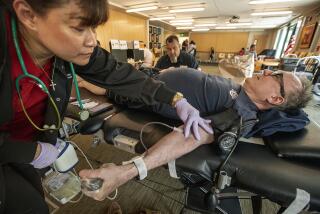Transfusion-Related Disease: ‘Time Bomb’ More Common Than AIDS
- Share via
Despite reassurances from some public health officials that the nation’s blood supply is safer than ever, the number of life-threatening infectious agents that can be transmitted through transfusions is actually growing.
While public awareness of the risks of tranfusions has been increased by concern over the AIDS epidemic, the likelihood of being infected with the AIDS virus is minuscule compared to the risk of acquiring another, sometimes debilitating, disease called non-A, non-B hepatitis.
“We are sitting on a time bomb,” said Dr. Gary L. Gitnick of the UCLA Medical Center. “Non-A, non-B hepatitis is the most significant tranfusion-related disease. It is certainly more significant than AIDS.”
The non-A, non-B hepatitis often has no symptoms but can cause severe fatigue, nausea and jaundice. It may also result in chronic liver inflammation and, after many years, the life-threatening scarring of the liver called cirrhosis.
The list of blood-borne infectious agents also includes cytomegalovirus, hepatitis B and, possibly, a leukemia virus and a second AIDS virus.
The growing concern about the safety of the blood supply has stirred unprecedented interest in alternate forms of transfusion, including stockpiling one’s own blood before having elective surgery, a procedure known as autologous transfusion.
Many doctors and patients are also thinking twice about transfusions that may not be necessary, according to Douglas MacN. Surgenor, president of the Center for Blood Research in Boston. In San Francisco-area hospitals, for example, there were 19% fewer red blood cell tranfusions in 1985 than in 1982, a survey Surgenor conducted earlier this year showed.
At medical meetings and in public statements, many health officials and blood bank directors have sought to reassure the public that blood is safer today than at any time in the past. But critics say such statements may be misleading because they minimize the substantial risks of receiving blood transfusions.
In 1986, about 7 million Americans will volunteer to donate more than 12 million units of blood, and about 4 million patients will receive transfusions of blood or blood products.
Blood is only rarely transfused as whole blood. Instead it is separated into red blood cells, which contain hemoglobin and transport oxygen; platelets, which help blood to clot, and plasma, a protein solution containing immunoglobulins to fight infections and blood-clotting proteins. Patients only receive the blood components that they require.
Each unit of donated blood now is tested for the presence of the virus that causes AIDS, non-A, non-B hepatitis and hepatitis B, and for syphilis.
From the early days of blood-banking in the late 1930s to the early 1970s, much of the nation’s donated blood was provided by paid donors.
Blood banks faced their first major infectious disease crisis after it was discovered in the late 1960s that many of these paid donors were infected with hepatitis B, often through intravenous drug use, and were transmitting the disease to transfusion recipients.
By the mid-1970s, screening all blood for hepatitis B and switching to volunteer blood donors sharply decreased the number of tranfusion-related hepatitis B cases.
But when careful follow-up studies were done, researchers were perplexed to find that a large number of blood recipients--from 7% to 17%--still had evidence of post-transfusion hepatitis.
Yet most donors and recipients tested negative for the hepatitis A and hepatitis B viruses. Thus the mysterious new illness was called non-A, non-B hepatitis.
(Because the screening tests are not foolproof, some transmission of hepatitis B still occurs, accounting for about 10% of the hepatitis caused by transfusions).
The viruses that are believed to cause non-A, non-B hepatitis have never been isolated. There is no effective treatment.
Two tests now are available to screen blood for non-A, non-B hepatitis. One is a test for a liver enzyme called ALT and the other is the “core antibody test.”
But both tests fail to detect up to two-thirds of those with the disease while giving positive results for many units of uncontaminated blood. The tests are inaccurate because they detect blood changes related to the disease, not the non-A non-B hepatitis viruses themselves. Without screening, transfusions recipients have had a 5% to 10% risk of being infected with non-A, non-B hepatitis. With screening, 3% to 6% will still likely contract the virus.
In the early 1980s, the Food and Drug Administration and blood-gathering organizations opposed the wide use of the screening tests for non-A, non-B hepatitis, citing their imprecisions as well as concern that the tests would lead to blood shortages.
It was not until this year, after a follow-up National Institutes of Health study was published in the Annals of Internal Medicine, that they changed their minds. Universal screening of blood with the ALT test began this fall. A decision about requiring testing with the core antibody test as well will be made in January.
Such screening could eliminate 50,000 cases of hepatitis and 2,500 cases of cirrhosis each year, according to the institutes’ study. About 150,000 cases of transfusion-associated non-A, non-B hepatitis and 7,500 cases of cirrhosis occur in the United States annually.
The ALT and core antibody tests are expected to add $3 to $5 to the cost of screening each unit of blood donated and decrease the number of units available for transfusion by about 5%.
Since March, 1985, with the introduction of a very accurate antibody test to screen blood for the AIDS virus, the risk of exposure to the deadly virus through a transfusion has declined markedly.
Currently, fewer than one to two of every 100,000 donated units of blood are estimated to be contaminated with the AIDS virus, according to Dr. James R. Allen of the federal Centers for Disease Control.
As of Dec. 1, there were 560 transfusion cases of AIDS and an additional 264 cases in hemophiliacs reported in the United States, according to the centers.
Earlier Transfusions
Many of the blood-borne cases of AIDS resulted from transfusions administered before March, 1983, when blood banks began to exclude high-risk donors, such as homosexual men and intravenous drug users.
For several years, the Red Cross and other blood-collecting agencies have been notifying recipients of blood from donors who later developed AIDS. The recipients can then determine if they have been infected with the virus and take steps to maintain their health and not transmit the virus to others.
In June, blood-collection agencies extended their notifications by establishing a “look-back” program to search for patients who received blood between 1977 and 1985 from donors who later tested positive for the presence of antibodies to the AIDS virus but who have not developed AIDS.
Difficult to Count
Red Cross officials have estimated that 2,500 to 5,000 Americans will be contacted through this program. But they don’t know how many exposed people will be missed, according to Dr. S. Gerald Sandler, an associate vice president of the organization. These will primarily be recipients of blood from members of AIDS risk groups who heeded warnings over the last three years to stop donating blood.
Some rare units of transfused blood are still contaminated with the AIDS virus, according to the Center for Disease Control’s Allen. This is because the current screening tests are not 100% accurate and some people at high risk for the infection have continued to donate.
After an individual has been exposed to the AIDS virus, it typically takes several months for the antibody test to become positive. And during this lag time, an infected person can transmit the infection through a blood transfusion.
Leukemia Fears
In addition to non-A, non-B hepatitis and the AIDS virus, concern has been expressed in recent months about the potential transmission by transfusions of a leukemia virus, called HTLV-I, and a second AIDS virus, called LAV-II.
The leukemia virus is common in some areas of Japan and has recently been found in intravenous drug users in New York City. Officials fear that it could be transmitted through transfusions. The Red Cross has begun a pilot program to check 30,000 blood donations for antibodies to HTLV-I to see if it is contaminating the blood supply.
The second AIDS virus has been found by French researchers in AIDS patients in West Africa and may represent a threat to the blood supply in Western Europe, according to Dr. Luc Montagnier of the Pasteur Institute in Paris. It has not been found in the United States.
Such “retrovirus” infections are particularly worrisome to blood bankers, because an individual may remain asymptomatic for years but be capable of transmitting the infection to others.
Better Tests Sought
Concern about retroviruses is spurring researchers to develop better blood tests, which can detect the AIDS virus earlier and which can also detect such related viruses. They may be widely used by blood banks within the next several years, according to Surgenor.
Attention has also been focused on transfusion-acquired cytomegalovirus infections. Pope John Paul II suffered this infection from transfusions after he was shot in 1981.
While harmless for most people, cytomegalovirus can cause serious illnesses, like pneumonia, in vulnerable individuals. Newborns as well as adults with abnormal immune systems, such as bone marrow transplant recipients, are increasingly receiving screened blood that does not contain the virus.
Before the end of the century, transfusion may undergo fundamental changes that will substantially reduce the risk of transfusion-transmitted diseases, according to Dr. Jay E. Menitove of the Blood Center of Southeastern Wisconsin in Milwaukee. Plasma proteins may be manufactured by recombinant DNA technology. Artificial red blood cells and platelets may also become available.
Techniques have already been developed to inactivate viruses and thereby improve the safety of blood proteins, such as the clotting factors required by hemophiliacs, according to Dr. Joseph Bove of the Yale-New Haven Medical Center. Bove is chairman of the American Assn. of Blood Banks committee on transfusion-transmitted disease.
These techniques cannot be used to improve the safety of red blood cells and platelets, because they would also damage the blood cells. But if researchers learn how to overcome this problem, it may be possible to inactivate even still undiscovered infectious agents, such as the viruses that are thought to cause non-A, non-B hepatitis.
But blood bank officials like Bove caution that “the only way to have a perfectly safe transfusion is not to have a transfusion.”
“The major challenge is to devise some kind of decision-making process that will allow us to balance how much risk we will take and how much blood we will transfuse,” he added.
Related story in View





